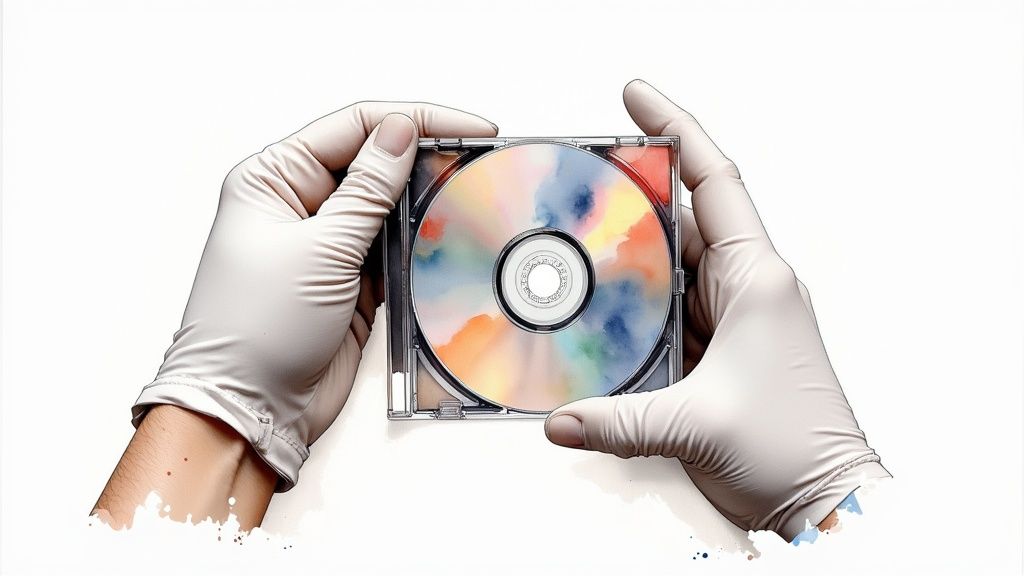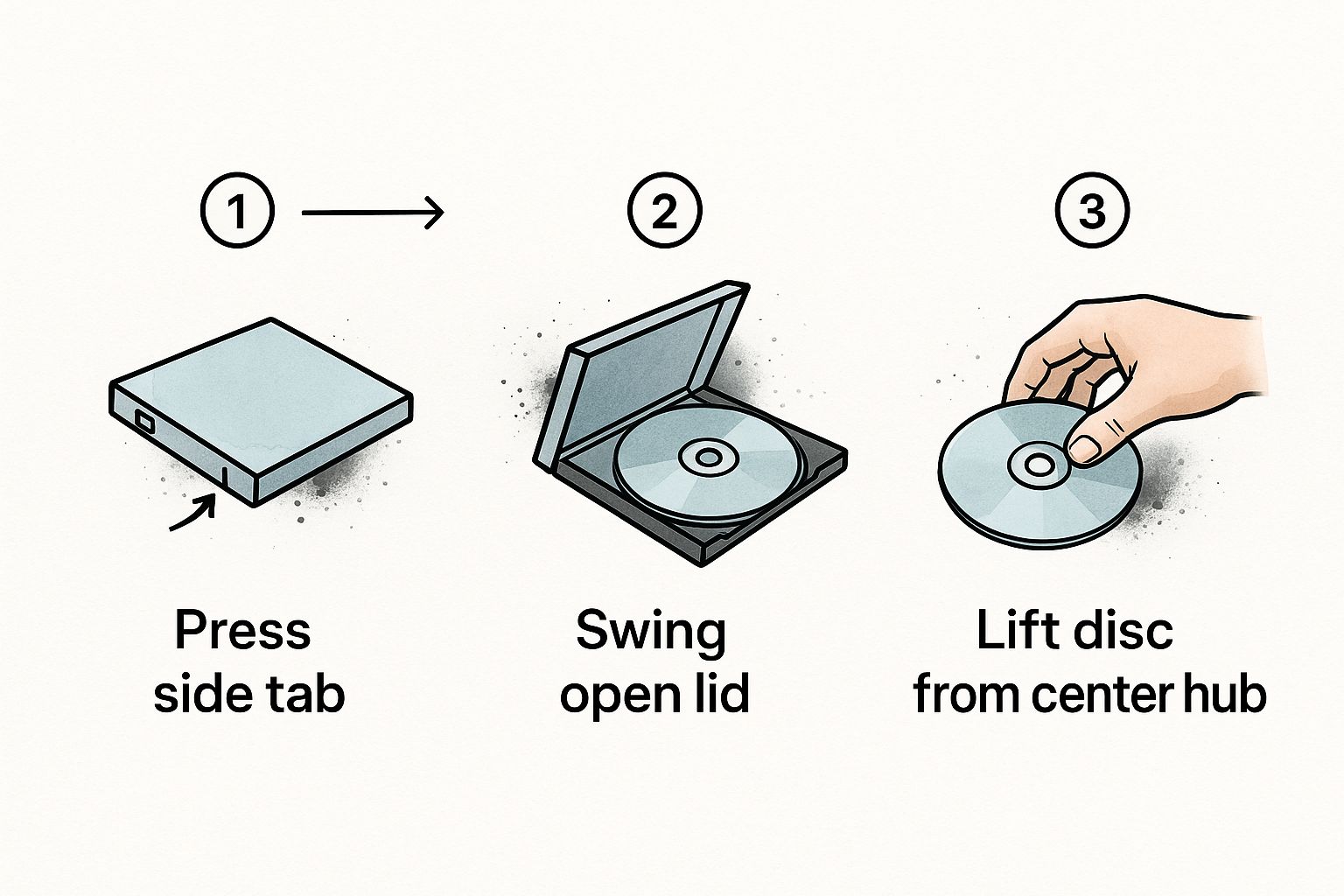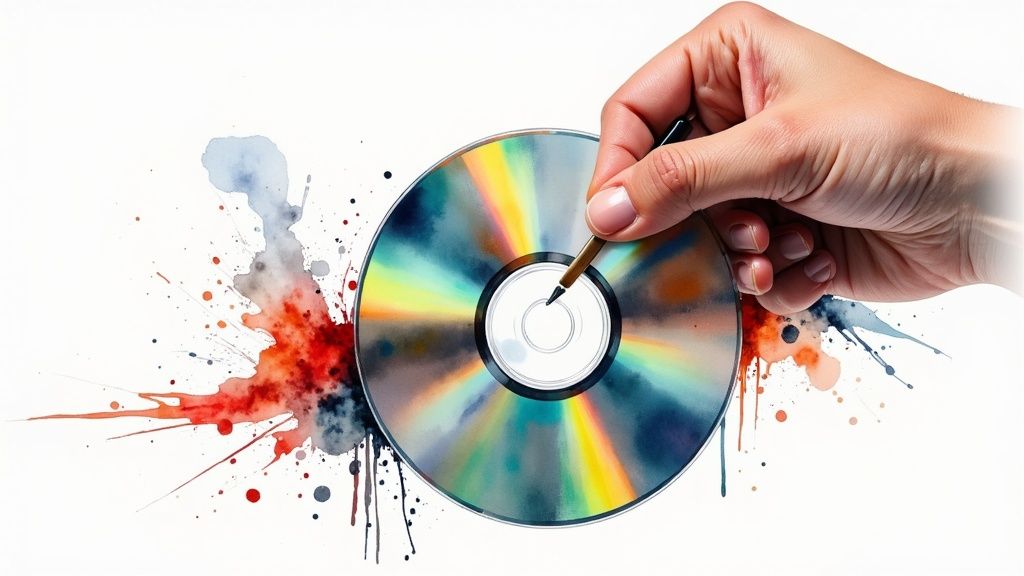Understanding What You're Actually Working With
Before you try to pry open that new CD, take a moment to look at what you’re holding. Learning how to open a CD case without damaging it starts with knowing what kind of packaging you're dealing with. Not all cases are made the same, and identifying the type is your best defense against cracked plastic or a scratched disc.
From my experience chatting with record store owners and fellow collectors, I've learned that correctly identifying the case is half the battle. A little care goes a long way in preserving your collection. Improperly opening a case can lead to fingerprints or scratches that make a disc unplayable. That's why pros always hold a disc by its outer edge. The packaging itself has evolved over the years, from the classic jewel cases to modern cardboard sleeves, each requiring a slightly different technique.
Common CD Packaging You'll Encounter
The two most common formats you'll come across are jewel cases and digipaks. A jewel case is that classic, hard plastic container we all know. They're infamous for being brittle, and the little tabs holding the cover can snap with almost no force. The secret is to apply gentle, even pressure rather than trying to force it.
A digipak, on the other hand, usually has a cardboard or paperboard binding with a plastic tray glued inside to hold the CD. While they often feel more premium, they come with their own set of challenges. The cardboard can bend easily, and the plastic "teeth" holding the disc in the tray can be surprisingly tight. You might also find simple cardboard sleeves or even elaborate box sets that have their own unique opening mechanisms.
To help you out, here’s a quick comparison of the most common packaging types and the best ways to open them.
CD Packaging Types and Opening Methods
| Packaging Type | Opening Method | Damage Risk | Best Practices |
|---|---|---|---|
| Standard Jewel Case | Gently pry the top edge open with your thumbs while holding the sides with your fingers. | High. The plastic is brittle; hinge tabs snap easily. | Use slow, even pressure. Avoid twisting or yanking the lid. |
| Slimline Jewel Case | Similar to a standard jewel case but thinner and more flexible. | Medium. Less likely to crack than standard cases, but still fragile. | Flex the case slightly to release the top cover. |
| Digipak | Open like a book. To remove the disc, gently press the center hub to release the "teeth". | Medium. Cardboard can bend or tear; plastic tray teeth can break. | Support the cardboard cover fully. Never pull the disc out without pressing the hub. |
| Cardboard Sleeve | Slide the disc out by pinching the sleeve lightly to create an opening. | Low to Medium. Risk of scratching the disc on the cardboard edge. | Hold the sleeve so the disc slides out onto a soft surface or into your other hand (held by the edges). |
Recognizing these different formats will turn a potentially frustrating moment into a smooth one. The main takeaway is to be gentle and deliberate, no matter which type of case you have. With a little practice, you'll be opening them like a pro without ever leaving a mark.
The Fundamentals of Safe CD Handling
After figuring out the packaging, the next essential skill is handling the disc itself. I’ve seen so many people grab a CD like a dinner plate, smearing fingerprints all over the shiny, readable surface. From years of collecting music and getting tips from audio pros, I can tell you that the oils and dirt from your fingers can mess with playback for good. A single tiny scratch is sometimes all it takes to make a disc skip or become unreadable.

This diagram of a CD’s layers shows just how thin and exposed the data layer is—it sits right under the label. This is why it’s so important to protect both the top and bottom of the disc to keep it working properly for years.
The Professional Grip and Inspection
The right way to hold a CD is always by its edges. You have two good options: either put your index finger through the center hole and support the outer rim with your thumb, or just gently pinch it by its opposite edges. This simple technique keeps your fingers completely off the data surface.
Before you pop a disc into your player, take a second to inspect it. Hold it up to a light and tilt it around to look for any major scratches, smudges, or cracks. This quick check can save your CD player’s laser mechanism from struggling with a damaged disc, which can cause its own set of problems.
Real-World Handling Scenarios
Sometimes the disc or its case puts up a fight. Here are a few common situations and how I’ve learned to deal with them:
- The Stuck Disc: If a CD feels cemented to the jewel case hub, don't try to pry it out from the side. That’s a fast way to snap it in half. Instead, press down firmly and steadily on the center hub’s “teeth” with your thumb. You’ll hear a satisfying click as the disc releases its grip.
- Pesky Promotional Stickers: Nothing is more annoying than a sticker slapped right over the case opening. If you just rip it off, you're often left with a sticky, ugly mess. A little heat works wonders here. Use a hairdryer on a low setting for just a few seconds to warm up the adhesive, and the sticker should peel right off without leaving residue.
- Handling Worn Discs: When you pick up a used CD that’s already seen better days, be extra careful. You can often clean minor smudges, but deep scratches are there to stay. Your main goal is simply to avoid adding any new damage.
Getting these physical handling techniques down is a key part of preserving your collection. On a related note, if you’re here for information about the financial instrument with the same name, check out our guide on how to calculate CD interest for more details.
Conquering the Jewel Case Challenge
We've all been there. You get a new CD, you're excited to pop it in, and then you're locked in a battle with the plastic jewel case. You pull, you pry, and you're just waiting for that awful snap of a broken hinge. It’s a classic frustration, but there's a surprisingly simple trick to opening them without a fight.
The secret isn’t about brute force; it’s about applying gentle pressure in the right spot. Most people try to open it like a book from the front edge, which is exactly what causes the problem. Instead, turn the case so the spine (the edge with the album title) is facing away from you.
Now, place your thumbs on the top edge, close to the corners where the lid connects to the back. While your other fingers support the bottom of the case, just press down and slightly forward with your thumbs. You'll feel a little give as the plastic flexes, which is all it takes to release the tiny clasps. The lid will swing open smoothly, no broken tabs in sight.
The Foolproof Opening Technique
This visual guide shows the simple, three-part motion for how to open a CD case without the struggle.

The key takeaway is that you're releasing the tension that holds the case shut, not forcing it open. This little bit of knowledge makes handling CDs so much easier. If you're also interested in the art and presentation of physical media, you might want to look into services that offer custom printed CD covers to give your projects a professional look.
Navigating CD Players and Drives Like a Pro
 Once you've safely freed a disc from its case, the next step is getting it into the player. This sounds simple, but not all players work the same way. Knowing the difference between the two most common systems—tray-loading and slot-loading drives—can prevent a scratched CD or a jammed machine.
Once you've safely freed a disc from its case, the next step is getting it into the player. This sounds simple, but not all players work the same way. Knowing the difference between the two most common systems—tray-loading and slot-loading drives—can prevent a scratched CD or a jammed machine.
A tray-loading drive is probably what comes to mind for most people. Found in home stereos and many computers, it has a tray that slides out for you. You just place the disc on the spindle and gently push the tray back in. Slot-loading drives, common in cars and newer laptops, are sleeker; they grab the disc and pull it in after you insert it partway. They are convenient but less forgiving if you don't insert the disc straight.
Tray vs. Slot: What You Need to Know
With a tray-loading drive, the most common mistake is not seating the disc correctly. If it’s off-kilter, the tray might close on it, leading to a nasty scratch or even a cracked disc. Always make sure it clicks securely onto the spindle.
For slot-loading drives, the biggest danger is using a disc that's already damaged, warped, or has a sticky label. These imperfections can cause the disc to get stuck inside the mechanism. Getting it out can be a real headache and sometimes requires professional help.
Even with the rise of streaming, the professional CD player market is surprisingly healthy. It's expected to grow from USD 1.96 billion in 2024 to about USD 2.12 billion by 2025. This shows that for people in fields like broadcasting and DJing, having a reliable and easy-to-use disc player is still a must. You can read more about these industry trends in this professional CD player market report.
No matter which type of player you have, the key is to be gentle and patient. Always check that your disc is clean and flat before putting it in, and never try to force a mechanism that seems stuck.
Why This Still Matters in Our Streaming World
You might think that knowing how to open a CD is a skill that went out with dial-up internet. After all, we live in a world where nearly any song or movie is just a click away on a streaming service. But the reality is that physical media, especially the compact disc, still holds a vital place for many people.
I've had conversations with serious audiophiles, professional archivists, and dedicated collectors, and they all say the same thing: proper CD handling is a skill worth having. Think about it from a professional standpoint. The music industry often uses CDs for mastering and distributing final audio tracks. Archival institutions rely on them for long-term data storage because a physical disc isn't vulnerable to a server crash or a change in a company's subscription terms.
Beyond the Mainstream
The CD's relevance isn't just a niche interest in developed countries. In many parts of the world, high-speed internet is either unreliable or prohibitively expensive. For millions, CDs are still a primary source of affordable and consistent access to music, software, and information.
This isn't just anecdotal. The global CD market was valued at around $1.5 billion in 2023. Projections show it growing to $2.1 billion by 2032, largely driven by a resurgence in collector interest and sustained demand in regions with limited digital infrastructure. You can find more details on the enduring CD market at dataintelo.com.
To understand why careful handling is so important, it helps to look at how different groups use CDs. The needs of a casual listener are very different from those of a professional archivist.
CD Market Segments and Usage Patterns
This table breaks down the different CD market segments and their typical handling needs.
| Market Segment | Primary Use | Handling Frequency | Damage Risk Level |
|---|---|---|---|
| Audiophiles | High-fidelity audio playback | Frequent | High (Scratches affect sound quality) |
| Data Archivists | Long-term data storage | Infrequent | Critical (Data integrity is paramount) |
| Collectors | Preservation and collection | Varies | High (Condition affects value) |
| General Consumers | Casual music/data access | Occasional | Moderate |
| DJ/Producers | Live performance/mastering | Very Frequent | Very High (Reliability is crucial) |
As you can see, for many users, the integrity of the disc is essential. A scratch on a collector's rare album or a bit of corruption on an archival disc can be a serious problem.
This is why mastering how to open a CD correctly isn't just about nostalgia—it's a practical skill for protecting valuable physical assets. It becomes especially important when you’re dealing with a rare live recording or a disc of irreplaceable family photos that you can't just re-download.
It's a funny parallel to the other kind of CD—the certificate of deposit. With both, understanding the value of what you're holding and how to keep it secure is the most important part. If you're curious about the financial side, you might find our article on whether CDs are safe investments for your money interesting, too.
When Things Go Wrong: Real Solutions for Common Problems
Even if you’ve mastered the art of opening a CD, accidents are bound to happen. You might hear the dreaded crack of a brittle case, watch a disc get swallowed by a player that refuses to give it back, or unearth a long-lost favorite that looks like it's been through a battle. When disaster strikes, take a breath. With a bit of patience, you can often fix the problem without making it worse. These are tried-and-true solutions that collectors and repair technicians have used for years.
Salvaging Discs from Broken Packaging
One of the most frequent mishaps is a jewel case shattering as you open it, leaving you with sharp plastic fragments and a trapped disc.
Here’s how to handle it:
- If the case is cracked but still holding together: Resist the urge to force it open. Instead, carefully snap off the remaining hinge tabs. This will let you separate the front and back pieces cleanly and avoid putting any more stress on the disc itself.
- If the center hub is broken: The plastic "teeth" holding the disc in place can get jammed. Your best tool here is a pair of needle-nose pliers. Gently snip away the broken plastic teeth of the hub one by one. Once they're gone, the disc should lift out easily. Whatever you do, don't try to pry the disc out from the edges.
When Discs Get Stuck
It's a sinking feeling when a player just won't eject your album. Before you resort to brute force, unplug the player. Take a close look for a tiny manual eject hole, which is usually located near the disc tray or slot. Straighten out a paperclip and gently push it into this hole. This action should trigger the manual release and pop the tray open. Be aware that this trick usually doesn't work for slot-loading drives, and poking around inside can damage the mechanism. If you have a stuck disc in a slot-loader, seeking professional help is the safest move.
Sometimes a disc gets stuck to its own packaging. This can happen in humid conditions where the paper booklet or liner notes fuse to the disc's surface. Do not try to peel the paper off. You risk stripping away the delicate data layer along with it. A safer approach is to submerge the disc in lukewarm distilled water for about an hour. The water should soften the paper enough that you can gently wipe it away with a soft microfiber cloth. This slow, careful method has saved many discs that seemed otherwise lost for good.
Protecting Your Collection for the Long Haul
Opening up a new CD is exciting, but how you treat it afterward will decide if it plays for a few years or a few decades. The biggest threats to your collection are often lurking in plain sight: high humidity, extreme temperatures, and direct sunlight. Any archivist will tell you that a stable environment is non-negotiable.
You should aim for a cool, dark spot with humidity below 50% to keep problems like disc rot and peeling labels at bay. This is precisely why that shoebox in the attic or the media rack basking in the afternoon sun are terrible storage spots for your prized albums.
Choosing Your Storage Method
The way you store your collection impacts both its lifespan and how easily you can find that one specific album you're in the mood for. Instead of cramming them into tight boxes, think about dedicated solutions. Something like AV five-tier media component shelves is a great choice because it allows air to circulate around the cases, which helps prevent moisture buildup.
For larger collections, the real trick is balancing easy access with long-term preservation. This is a lot like managing your money—you want some of it liquid while the rest grows over time. We explore a similar idea for your finances in our guide on the CD ladder strategy, which shows how to balance different term lengths for the best results.
Curious to see what this kind of strategy could do for your savings? Plug your numbers into our free Certificate-of-Deposit Calculator and get an instant look at your potential growth.